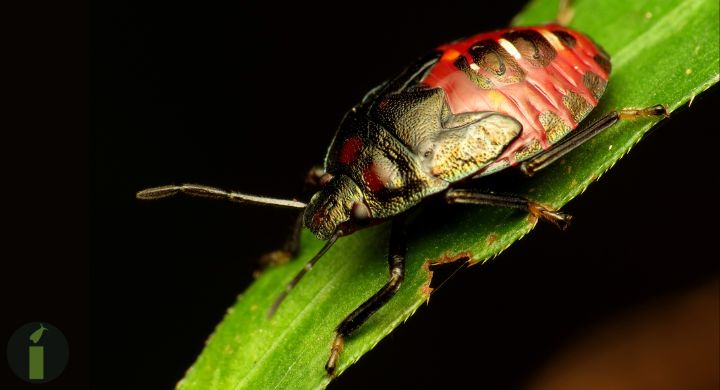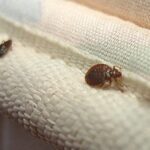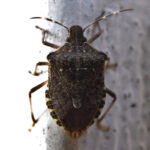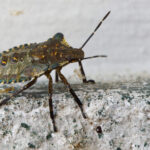In Texas, stink bugs may be a major annoyance for homeowners, especially in the summer. These shield-shaped insects are unpleasant to have around because they release an offensive stench when disturbed. Let’s say you’re searching for efficient ways to get rid of a stink bug infestation. If so, you’ve arrived at the ideal location. We’ll provide you with detailed directions and advice on how to get rid of stink bugs in Texas in this extensive article. We can help you with everything from comprehending their behavior to putting preventative measures and natural cures into action.
Adults are solid green, measuring between 1/2 and 3/4 of an inch in length. The color of immature stages varies; very small nymphs are black, while larger nymphs are green. On the abdominal segments, the immature stages, however, feature a characteristic pattern of yellowish patches. Because the eggs are in clusters that resemble rows of little barrels on and around adequate food sources, nymphal stages are together in large numbers. It takes roughly 35 days for an egg to become an adult, though this depends on the temperature. There could be as many as five generations per year, with the highest numbers emerging in the fall before the adults hibernate.
Table of contents
- Species of Texas Stink Bugs
- Classification of Texas Stink Bugs
- Origin & Distribution of Texas Stink bugs
- Why are they called stink bugs?
- Do Texas Stink Bugs bite?
- How Much Does It Cost to Get Rid of Texas Stink Bugs?
- Texas Stink Bug Facts
- Life Cycle of Texas Stink Bug
- What do Texas stink bugs eat?
- Preventing Texas Stink Bug Infestations
- Fix or Replace Damaged Screens
- Planting Repelling Plants in Your Garden
- Professional Pest Control Services
- Prevent Texas Stink Bug Infestation in the Future
- Long-Term Remedies using Natural Repellents
- Proper Storage of Fruits and Vegetables
- Frequent Sanitation and Cleaning
- Observe and Take Quick Action
- Frequently Asked Questions (FAQs) About getting rid of Texas Stink Bugs
Species of Texas Stink Bugs
There are various species of Texas stink bugs. Conchuela stinks bug (Chlorochroa ligata; Say); brown stink bug (Euschistus servus); harlequin bug (Murgantia histrionica; Hahn); rice stink bug (Oebalus pugnax; Fabricius); and spined shouldered stink bug (Podisus maculiventris; Say) are among the many species of stink bugs that are common in Texas. While some, like the spined-shouldered stink bug, are predators of other insects, the majority only graze on plants. Brochymena arborea (Say), one species of stink bug, gets its name from the color and texture of the tree bark that it inhabits.

Classification of Texas Stink Bugs
The family Pentatomidae includes the insect species known as stink bugs. Their bodies are like shields, and they have a really bad smell. The most prevalent Texas stink bug species are as follows:
- The brown marmorated stink bug.
- The green stink bug.
- The southern green stink bug.
These pests harm agricultural products by feeding on a variety of plants, fruits, and crops.
Origin & Distribution of Texas Stink bugs
Texas stink bugs, particularly the brown marmorated stink bug are indigenous to China, it has spread to South Korea, Japan, and the United States. There are 46 states in the US where Texas stink bugs of brown marmorated type have been discovered. From detections to major infestations and agricultural damage, the amount of the population and the ensuing harm varies from state to state.
Although there are a few native stink bugs in the United States, the most dangerous kind is the brown marmorated stink insect, which is an invasive species with no natural enemies. They have now spread throughout the Mid-Atlantic, Mid-South, and Appalachia after being discovered for the first time in eastern Pennsylvania in the 1990s. States like Florida, Mississippi, Louisiana, Arkansas, and Texas are home to them less frequently.

Why are they called stink bugs?
Texas stink bugs have lived up to their moniker, as you may have imagined! According to Walgenbach, “When disturbed, glands in their abdomens emit a pungent odor to serve as a defensive compound.” The potent scent can linger for hours, yet it’s not toxic or harmful to humans or animals. People have said that it smells like everything from cilantro to almonds.

Do Texas Stink Bugs bite?
The good news is that insects don’t bite or sting people, and they don’t carry illness or harm buildings. Crops pose the greatest threat to them. According to Walgenbach, although you might find them repulsive, for the majority of homeowners they are only an annoyance.

How Much Does It Cost to Get Rid of Texas Stink Bugs?
The cost to remove Texas stink bugs varies greatly depending on the difficulty of reaching them, the quantity that must be eliminated, and the extent of the necessary repair work to keep them out of the building. However, depending on where you reside in the United States, a typical pest control visit from a reputable pest control firm should cost between $200 and $600, according to several pest management websites.

Texas Stink Bug Facts
Only the rare individual who is allergic to brown marmorated stink bugs is at risk, and they do no structural harm, although they can be major pests of crops like soybeans and apples. Nevertheless, as stink bugs are quite mobile, the one you see today could not be the same one you see next week if you observe them munching on your plants in the spring or summer. Sometimes they can cover up to a mile at a time.
Sap-feeding brown marmorated stink bugs prefer not to cause too much difficulty or attract attention to themselves. Damage is usually intermittent, but if many stink bugs are present at once, it may become extremely serious. As a result of the stink bug’s brief visitation, plants may temporarily release pleasant sap, which occasionally draws ants and wasps in.
Although they may live in a variety of settings, stink bugs have difficulty surviving in low temperatures (below 10 degrees Fahrenheit). With varying degrees of success, they have spread over the majority of the United States since its unintentional introduction in the mid-1990s.
Although there aren’t many natural predators for the brown marmorated stink bug in the United States due to its introduction, some generic hunters will take strong aim at them. Furthermore, immature stink bugs will become the host for parasitic wasps’ eggs. The developing stink bug is utilized as food when the eggs hatch. Every stage of stink bug life will be consumed by other animals, such as birds.
Life Cycle of Texas Stink Bug
The life cycle of a Texas stink bug is egg, nymph, and adult, just like a real bug. Up to two generations may occur, depending on the area. Like other southern parts of the United States, Texas is likely to have two generations of Texas stink bugs.
They become adults in the spring. When the weather and day length are right, adults leave their overwintering locations—such as houses, buildings constructed by humans, and tree bark. After that, adults will go for food sources, such as the Tree of Heaven and numerous other hosts. Although they will begin mating in the spring, adult females need more time to get ready. Females usually deposit masses of eggs on the undersides of leaves after mating. A mass of around 28 eggs is present on average.
Almost simultaneously, first-instar young insects hatch from the eggs and settle on top of the egg mass. The insects leave the egg mass when they reach the second instar and feed on the plant tissues. After the second instar, all immature stages keep feeding on the plant. The adult brown marmorated stink bugs will feed, mate, and deposit multitudes of eggs for the following generation after completing their embryonic growth.
What do Texas stink bugs eat?
Broadly speaking, Texas stink bugs consume a variety of plants as hosts, including cotton, peaches, tomatoes, and seeds like soybeans, sorghum, and pecans. They also enjoy the components of many wild and ornamental plants. These persistent pests can seriously harm developing fruit and plants, which will reduce your yield and detract from the general aesthetic appeal of your garden. To reduce the harm they can do and manage their number, action must be taken.
Preventing Texas Stink Bug Infestations
Sealing any access points and taking steps to make your home less appealing to stink bugs are essential to preventing an infestation. The following advice will help keep stink bugs out of your house:
Seal Entry Points
Examine and caulk any holes, fractures, or openings in the siding, windows, doors, and foundations. Since stink bugs may squeeze through even tiny gaps, sealing everything tightly is crucial.
Install Screens
To keep stink bugs out of your house while enabling airflow, install fine mesh screens on your windows, doors, and vents.
Weather Stripping
Make sure your windows and doors are properly weather-stripped to minimize entry opportunities for stink bugs and to establish a tight seal.
Cleanliness
Since food sources attract stink bugs, it’s critical to keep your home spotless and clear of spills and crumbs. To get rid of possible food sources, empty and clean garbage cans regularly, vacuum carpets and furniture, and wash down surfaces. You can discourage stink bugs from entering your home by taking away their preferred food source.
Fix or Replace Damaged Screens
As soon as possible, replace or repair damaged screens to close any possible openings.
Planting Repelling Plants in Your Garden
Planting specific plants in your yard will help keep stink bugs away because they naturally dislike these pests. Incorporate garlic, mint, catnip, and marigolds into your garden beds. These plants naturally repel stink bugs by releasing odors that they find disagreeable. Add a layer of security by growing these repellent plants next to crops that are susceptible to damage or access points.
Close Doors and Windows
Close windows and doors, especially when stink bug activity is at its highest.
Outdoor Lighting
Lights draw the attention of stink bugs. Since yellow outdoor lighting is less appealing to them, think about utilizing it.
Remove Debris
Texas Stink bugs can use foliage, weeds, and debris as hiding spots, so get rid of them near your house.
Limit Moisture
Moisture is what attracts stink bugs. Resolve any leaks and make sure wet locations, such as crawl spaces and basements, have enough ventilation.
Essential Oils
Essential oils work wonders as a bug deterrent since various smells attract Texas stink bugs. Try utilizing oil of ylang-ylang, clove, spearmint, or lemongrass. Apply a few drops of the selected oil, diluted with water, to stink bug infestations. Pay attention to doorways, windowsills, and other points of entry. To keep the spray effective, use it every few days or after a rainstorm.
Diatomaceous Earth
There is a non-toxic powder taken from diatoms, called Diatomaceous earth. It works incredibly well against a variety of insects, including stink bugs. Apply a thin layer of diatomaceous earth to any probable entry points or areas where stink bugs may congregate. The powder’s sharp edges will pierce the exoskeleton of the stink bugs, causing them to get dehydrated and eventually die. Use only food-grade diatomaceous earth, and make sure you apply it safely by following the directions.
Soapy Water
A straightforward solution of soapy water can work well as a stink bug trap. Pour two cups of boiling water, one cup of white vinegar, and half a cup of dish soap into a spray bottle. Give the mixture a good shake before spraying stink bugs directly. Soap breaks down their bodies which have a waxy layer, which results in asphyxia and death. This approach offers a stopgap measure for instant management.
You can use these all-natural remedies separately or in combination to successfully ward against and get rid of stink bugs from your house and yard. It’s crucial to remember that you need to use natural treatments again and might not completely get rid of serious infestations.
DIY Light Trap
Light sources, especially in the evening, are what attract stink bugs. To make a light trap, you’ll need a small desk lamp or other light source, a shallow pan filled with soapy water, and some cardboard or paper. Using the cardboard or paper as a ramp to the pan’s edge, place the pan of soapy water underneath the light source. In the evening, turn on the light, and stink bugs will gravitate toward it. After landing on cardboard or paper, they will plunge into soapy water, becoming stuck and unable to get out. Regularly check and empty the trap.
DIY Sticky Trap
Sticky traps are another effective way to capture stink bugs. You will need a flat surface, such as a piece of cardboard or a disposable tray, and a sticky substance, such as adhesive tape or glue. Apply the sticky substance onto the surface, ensuring it covers the entire area. Place the trap in areas where stink bugs are frequently seen, such as windowsills or near entry points. The stink bugs will be attracted to the trap, land on the sticky surface, and become stuck. Dispose of the trap along with the trapped stink bugs.
DIY Soda Bottle Trap
Soda bottle trap also captures Texas Stink bugs. Take a plastic soda bottle, cut off the top third, and flip it so that the top third is within the bottom two-thirds. Use tape to firmly join the two parts. Roll a piece of paper and slide it into the bottleneck to form an entry point in the shape of a funnel. Apply a glue or soapy water mixture to the inside of the trap. The trap will attract stink bugs, which will then enter via the funnel and become imprisoned inside. Regularly check and empty the trap.
Don’t forget to carefully position these handmade traps in stink bug hotspots. To keep the traps effective, check and empty them frequently.
Professional Pest Control Services
If you have a serious or ongoing stink bug infestation that DIY traps or natural therapies cannot sufficiently treat. In that instance, it might be essential to hire a pest control expert. Expertise and specific tools are available from pest control firms to get rid of Texas stink bugs in your house.
Think about getting in touch with a reputable pest control business if:
- There is a massive and pervasive stink bug invasion.
- Results from natural therapies and do-it-yourself techniques have not yet been adequate.
- You can’t control the infection by yourself.
Prevent Texas Stink Bug Infestation in the Future
To keep an area free of Texas stink bugs, it is imperative to prevent more infestations. You may drastically lower the chance that stink bugs will return to your property by taking preventative steps and maintaining your property regularly. Here are some pointers to avoid infestations in the future:
Frequent upkeep and examination
- Examine your house daily, inside and out, to find any possible entryways or places stink bugs could gather.
- To make sure that stink bugs cannot enter your home, seal off any new cracks or gaps that can appear over time.
- Fix any broken window screens and make sure there are no gaps in their tight fit.
- Moist areas attract Texas Stink bugs, so look for leaks or moisture problems.
- Reduce the amount of bushes and plants close to your house to help reduce potential stink bug hiding places.
Long-Term Remedies using Natural Repellents
- To naturally deter stink bugs from entering your garden, keep adding plants that ward against them.
- Think about adding helpful insects to your yard, like praying mantises or ladybugs. These insects can aid in the natural management of stink bug populations.
- Use organic insecticides that are safe for the environment and beneficial insects, and that target stink bugs or other pests.
Proper Storage of Fruits and Vegetables
- Before bringing any fruits or veggies home, make sure to inspect and clean them. Produce can harbor stink bugs, which can swiftly infiltrate your house.
- To avoid attracting stink bugs, store ripe or overripe fruits in the refrigerator or sealed containers.
Frequent Sanitation and Cleaning
- Texas Stink bugs like organic waste and debris, so keep your home tidy and clear of clutter.
- Regularly vacuum, being mindful of door frames, windowsills, and other potential gathering spots for stink bugs.
- Throw away vacuum bags or quickly empty the canister to stop stink bugs from getting out.
Observe and Take Quick Action
- Watch out for any indications of stink bugs, such as smells or sightings.
- As soon as you see stink bugs, use the techniques outlined in the guide to either catch them or get rid of them.
- Take immediate action to stop stink bugs from proliferating and growing in number.
Frequently Asked Questions (FAQs) About getting rid of Texas Stink Bugs
Common chemical sprays can be used around windows or other areas where stink bugs tend to gather, or they can be used around common access sites. Deltamethrin is a pesticide that kills stink bugs.
Indeed, eliminating one stink insect may draw in additional ones. Stink bugs emit an offensive odor when they are threatened or squished, which might draw additional stink bugs to the area. So, it’s important to avoid killing them if possible. Rather, attempt to keep them out of your house by caulking any openings or fractures in the outside walls and windows. If a stink bug is discovered inside your house, attempt to get rid of it by hand or with a vacuum.
You can sweep or vacuum up any stink bugs that are present in your house. Kauffman advises emptying the bag outside and vacuuming with a HEPA filter to reduce the stench.
Stink bugs are tiny, innocuous insects that, when crushed, release an awful stench. Although these insects can be a major annoyance, there are numerous strategies to avoid them. To stop the stench from stink bugs from spreading throughout your house, carefully sweep up or catch them. By caulking gaps, reducing lights, and applying insecticide to your external walls, you can keep these pests out of your house.
Stay tuned to insectinsider for more details about insects around us.










